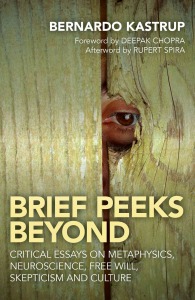A recurring theme in popular culture, at least since the birth of the New Thought movement in the 19th century, has been what I call the ‘intentional mind-over-matter hypothesis’: the notion that our thoughts can deliberately and directly influence reality.
According to the hypothesis, we should be able to purposefully mold reality – at least to a small extent – to our own wishes by the use of mental practices such as positive thinking, visualization, affirmations, etc. Documentary films and books like The Secret have given a renewed, modern spin to this idea, spreading it far and wide.
My own view is that reality unfolds entirely in consciousness – the medium of all thoughts – as opposed to a strongly objective world outside consciousness. This view is called monistic idealism. One may then legitimately wonder if monistic idealism doesn’t lend support to the intentional mind-over-matter hypothesis. After all, if both thoughts and empirical reality are in consciousness, it doesn’t seem to be at all implausible that they could influence each other. But is the possibility of an intentional mind-over-matter effect a necessary implication of monistic idealism? The answer isn’t as straightforward as it may seem.
Before we can address the question fairly, some brief background is required. According to monistic idealism, all reality is in a transpersonal form of consciousness that transcends your personal psyche alone. Thus, it is your body-brain system – as a part of reality – that is in consciousness, not consciousness in your body-brain system. The body is an outside image of a process of localization of experiences in transpersonal consciousness, like a whirlpool is the image of a process of localization of water in a stream. For exactly the same reason that a whirlpool doesn’t generate water, your brain doesn’t generate consciousness. Yet, because an outside image of a process correlates tightly with the inner dynamics of the process, brain activity correlates with subjective experience. Active neurons are what our localized, personal experiences look like from the outside, not their cause.
As such, it is true that positive thinking, affirmations and visualizations can affect the reality of our personal psyches and bodies: they can change our emotions, general outlook on reality and even our physical health. After all, these thoughts, affirmations and visualizations are experiences created by, and unfolding within, the whirlpool that we identify with as personal entities. Disturbances arising within the whirlpool can, of course, directly influence the whirlpool’s inner dynamics. They can also indirectly influence the broader stream through contact with the rim of the whirlpool: with the use of our arms and legs, we can physically act upon our thoughts to change reality at large. We do this every day when we wipe the floor, move furniture around or build a house with our own hands.

The question, of course, is whether our localized mental activity can directly influence the world without the physical mediation of our body. Can a disturbance created within the whirlpool remotely affect the flow of water on the other side of the stream, without any form of contact with the rim of the whirlpool?
Framed this way, the answer doesn’t seem all that obvious anymore, does it? Indeed, monistic idealism doesn’t necessarily imply that we can ‘attract’ a promotion or the ideal lover by merely visualizing it. It doesn’t necessarily imply that thoughts or imagination within the whirlpool can remotely affect anything outside of the whirlpool. The consensus world clearly unfolds according to stable patterns and regularities that we’ve come to call the ‘laws of nature.’ Monistic idealism doesn’t deny this; it simply brings these patterns and regularities into the scope of consciousness: they become certain ‘laws of consciousness,’ so to speak.
Yet, monistic idealism also doesn’t refute intentional mind-over-matter effects. It is true that disturbances arising within a whirlpool can influence the stream outside by going through the rim of the whirlpool – that is, through body-mediated, physical intervention in the world. But there may also be ways for disturbances to propagate under water. Indeed, what we call the physical world is the ripples propagating on the surface of mind-at-large. They are all we can ordinarily perceive. The glare of the surface obfuscates the currents and disturbances that may be flowing underneath, so we can’t discern them in a self-reflective manner. It is thus conceivable that thoughts and imagination originating in our personal psyche, if they somehow sink into the deepest, most obfuscated, collective levels of consciousness, could indeed affect consensus reality directly.
According to monistic idealism, the physical world is an outside image of collective mental processes. But the image of a process doesn’t necessarily reflect all there is to know about the process. Flames don’t tell all there is to know about combustion. Lightning doesn’t tell all there is to know about atmospheric electric discharge. Our physical appearance doesn’t tell all there is to know about our state of health. Therefore, what we ordinarily perceive as physical cause and effect reflects merely the visible regularities of the unfolding of those collective mental processes. There may be a lot more going on beyond our view. Moreover, our understanding of even these visible regularities is very incomplete. We do not know that the physical world is causally closed, or self-contained. As such, the empirical reality we ordinarily perceive may be just the surface of an ocean of untold depth. Unfathomable complexity may lie immersed, obfuscated from view by the glare of the surface.
In one of his many wonderful talks, Alan Watts related a very evocative analogy for what we call physical causality: he asked his audience to imagine themselves sitting in front of a wooden fence, with just a thin slit allowing them to see what lies on the other side of the fence. If a dog were to walk along the other side, one would first see the dog’s head through the slit and, a little while later, the dog’s tail. Every time the dog would walk along the fence, one would first see the head and then the tail. Watts then argued that we would, very naturally, conclude that the dog’s head causes the dog’s tail. The logic behind this conclusion seems indeed impeccable.
You see, if all we have is a partial view of what is actually going on – a small slit in the fence – our understanding of the chains of cause-and-effect in nature may be very limited and inaccurate. The dog’s head obviously doesn’t cause the tail, even though every empirical observation through the slit would consistently reinforce this erroneous conclusion. The head and the tail are just regularities of a broader pattern unfolding beyond ordinary perception; namely, a walking dog. If consensus reality is merely a partial image of obfuscated, collective mental processes, our position as its observers may be entirely analogous to that of the person sitting in front of the wooden fence. The true, complete causal processes behind our observations – that is, the actual dog walking by – may lie in obfuscated depths below the surface. It is thus conceivable that, by somehow allowing our self-created thoughts and imagination to sink into the lower depths of the psyche, we could plug them into the actual causal chains of nature, whose effects could spread far beyond us. By allowing them to sink in we could conceivably release them into wide-ranging underwater currents.
In conclusion, monistic idealism does not necessarily imply that one can directly influence consensus reality through positive thinking, affirmations or visualizations. In fact, it implies precisely that, for as long as our self-created thoughts and imagination remain in our personal psyche, they cannot influence reality at large. At best, they could influence our mental and emotional outlook, as well as physical health. But monistic idealism does leave a door open for intentional mind-over-matter effects when our self-created thoughts and imagination are allowed to sink into the lower, collective levels of the psyche.
How this form of release can be intentionally accomplished is unclear. After all, for as long as our personal intentions remain personal, they are still circumscribed by our personal psyches and cannot affect the world. But it is conceivable that techniques or skills for achieving the effect may have been developed through the course of history. It is also conceivable that the effects could grow if the techniques or skills were to be applied by a large number of people working in synch, as some studies on meditation suggest.
 Bernardo Kastrup
Bernardo Kastrup has a Ph.D. in computer engineering with specializations in artificial intelligence and reconfigurable computing. He has worked as a scientist in some of the world’s foremost research laboratories, including the European Organization for Nuclear Research (CERN) and the Philips Research Laboratories (where the “Casimir Effect” of Quantum Field Theory was discovered).
Bernardo has authored many scientific papers and five philosophy books:
Rationalist Spirituality
Dreamed up Reality
Meaning in Absurdity
Why Materialism Is Baloney
Brief Peeks Beyond.
He has also been an entrepreneur and founder of a successful high-tech start-up. Next to a managerial position in the high-tech industry, Bernardo maintains a philosophy blog, an audio/video podcast, and continues to develop his ideas about the nature of reality. He has lived and worked in four different countries across continents, currently residing in the Netherlands.
www.bernardokastrup.com

 Bernardo Kastrup has a Ph.D. in computer engineering with specializations in artificial intelligence and reconfigurable computing. He has worked as a scientist in some of the world’s foremost research laboratories, including the European Organization for Nuclear Research (CERN) and the Philips Research Laboratories (where the “Casimir Effect” of Quantum Field Theory was discovered).
Bernardo Kastrup has a Ph.D. in computer engineering with specializations in artificial intelligence and reconfigurable computing. He has worked as a scientist in some of the world’s foremost research laboratories, including the European Organization for Nuclear Research (CERN) and the Philips Research Laboratories (where the “Casimir Effect” of Quantum Field Theory was discovered).











Add Your Thoughts/Comments Below